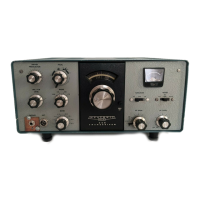5
Receive Improvements:
The receiver’s strong signal-handling capability and audio quality can be vastly improved
by the following changes:
During alignment check to see if, while adjusting T-102 (Figure 3), there are two points
where the transformer can be peaked -- one spot for transmit and a slightly different
setting for receive. If so, peak the transformer for maximum transmit drive instead of
maximum receive gain. The receiver has an abundance of gain, however the transmitter
could use a little extra. This will get rid of some of the receiver gain but WILL NOT
affect receiver sensitivity.
Also change the value of the screen dropping resistor R113 in the second I.F. amplifier
V4 from 1KΩ to 10KΩ (Figure 3). This will reduce the gain of this stage a bit and
improve gain distribution.
The next step in receive improvements is to increase the BFO drive to the product
detector. The BFO (carrier oscillator) injection to the product detector should be about
five times the level of the I.F. signal for low distortion. On these rigs, the I.F. signal can
equal the BFO injection level under strong signal conditions resulting in a very raspy,
distorted audio quality. I have even noted at times some pulling of the BFO oscillator
frequency. The major problem is that during receive, the BFO signal is coupled to the
product detector cathode through C17, a 12pf silver mica capacitor which is connected to
a piece of coax running to the product detector cathode. The capacitance of the coax
cable exceeds the value of coupling capacitor C17, and the combination of the two acts as
a voltage divider, greatly reducing BFO drive level to the product detector V13C.
Correcting this involves increasing BFO drive and decreasing the I.F. drive to V13C.
To increase BFO drive, simply replace coupling capacitor C17 on the modulator board
with a 100pf silver mica, and replace the 33KΩ resistors R6 and R7 on the modulator
board with 27KΩ resistors (Figure 4). To reduce I.F. drive, change resistor R123 on the
I.F. board from 470Ω to 75Ω (Figure 3).

